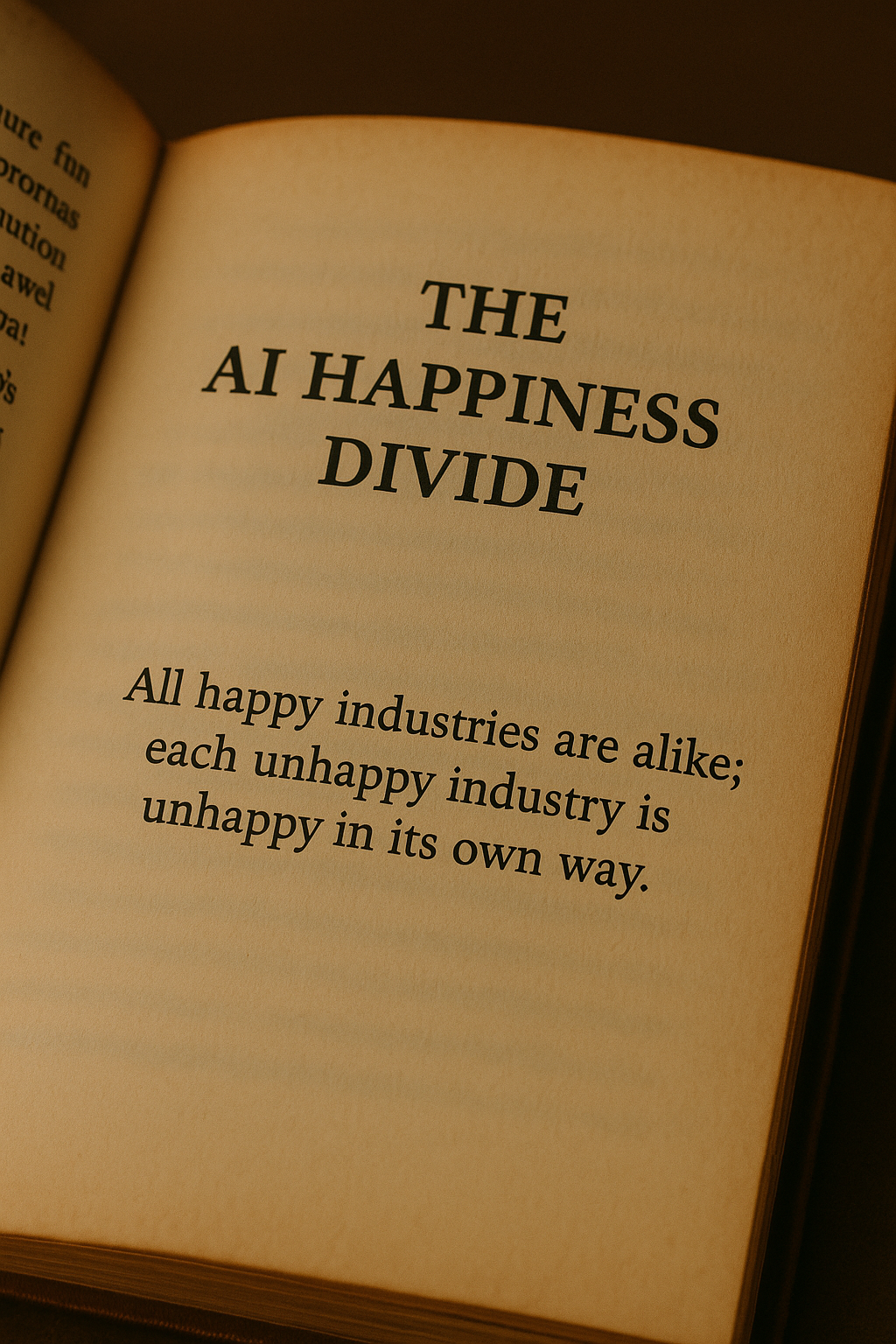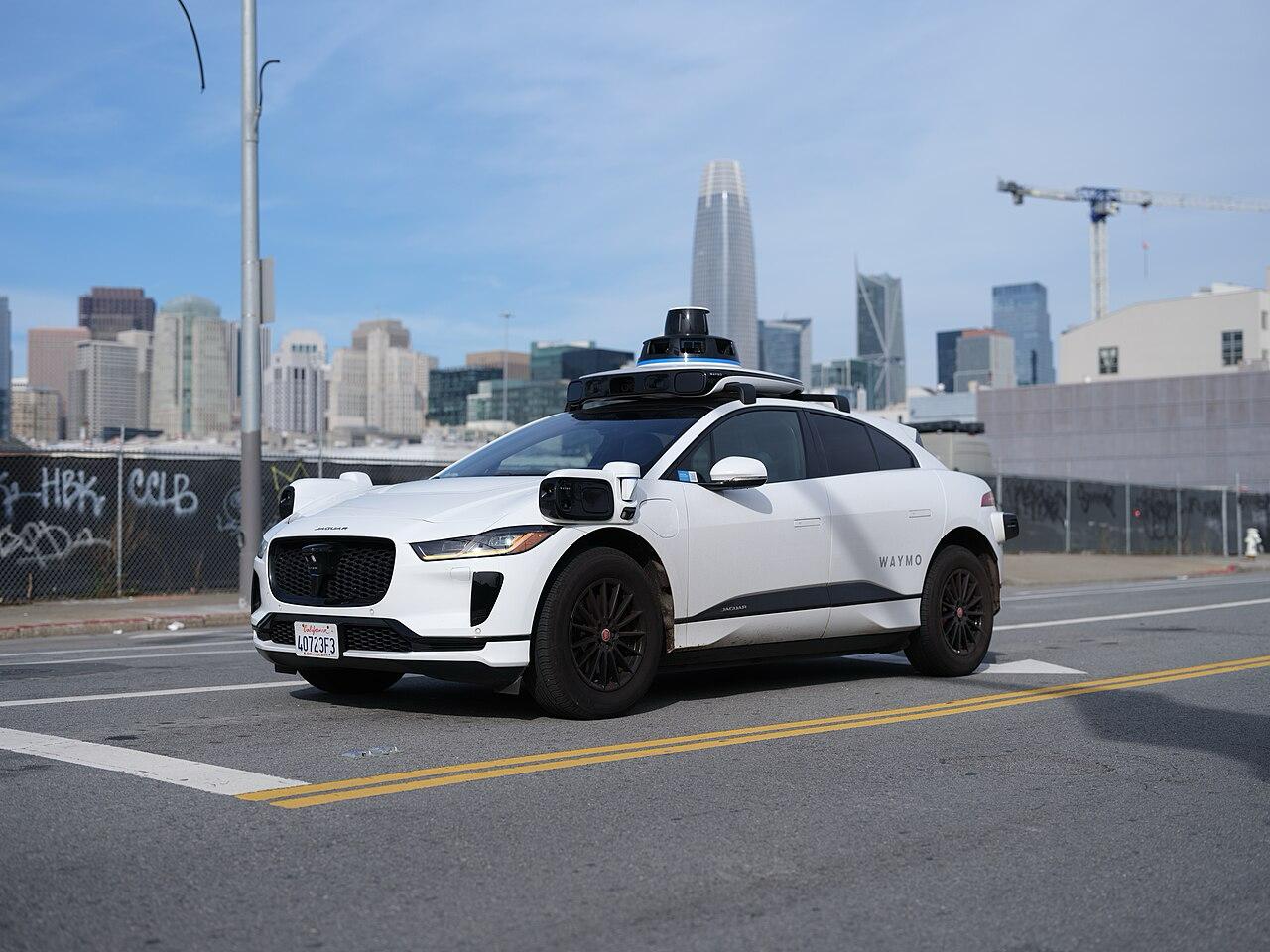Greetings, AI Thinkers,
Today, we explore the AI Happiness Divide — why some individuals and organizations thrive with AI, while others fall behind.
You’ll find:
- A framework of 8 key factors that shape AI-driven success (with 8 more for deeper insight).
- Case studies from the robotaxi, video, and coding industries.
- Practical questions to assess your own readiness.
These factors are not merely theoretical — they serve as practical tools for personal and organizational strategy in the age of AI.
Happy Thinking,
Dr. Yesha Sivan and the MindLi Team
P.S. Feedback? Email me.
Spark of the Week: The AI Happiness Divide — Your Happiness Depends on These 8 Factors (Source: Yesha on Human Thinking)

Motivation and Overview
Your personal and organizational success hinges on how effectively you adapt to the AI wave, which will influence your productivity, resilience, and long-term relevance. Some industries will change significantly, some will change slightly, some will disappear, and some will emerge or reemerge.
If you’re reading this, you already know that AI surpasses the printing press, electricity, cars, the internet, and mobile phones. But what will AI bring to my industry, and how can you prepare for it?
Today, I will list 8 factors you should consider when planning your transition. In the spirit of time management, I will first list these factors briefly and then elaborate on them. The elaboration will primarily draw from three industries: Robtaxies, video, and coding.
The Top Factors to Think About in Your Industry
Here’s the bottom line: these are the top 8 factors to help you think clearly and strategically about your future in an AI-driven world.
- Time to Impact – Is the solution ready yet?
- Nature of Outcome Change – What is the nature and extent of the change that AI brings?
- User Willingness – Are core users open to adopting the AI solution?
- Customer Trust and Acceptance – Do customers trust and pay for AI-generated output?
- Regulatory Risk – What legal or safety obstacles might hinder deployment?
- Data Availability – Is there sufficient quality data to support the AI?
- Skill Transferability – Can current workers reskill for AI-enhanced roles?
- Scope for New Directions – Can AI create new products, services, or markets?
Now let’s dive into the cases and the factor analysis (including a bonus of 8 more factors generated with help from OpenAI’s GPT-3o model):
Industry Case 1: Robtaxies
The industry has been evolving for over a decade, with Waymo, an Alphabet (Google) subsidiary, emerging as the clear leader. After investing billions of dollars and conducting extensive real-world testing, Waymo now operates fully autonomous taxi services in cities such as Phoenix, San Francisco, and Los Angeles. As of 2024, Waymo vehicles have completed over 20 million miles of autonomous driving.
A 2023 study titled “Comparative Safety Performance of Autonomous- and Human Drivers: A Real-World Case Study of the Waymo One Service” found that over 3.8 million miles driven in rider-only mode, Waymo’s autonomous vehicles had zero bodily injury claims, compared to 1.11 claims per million miles for human drivers. Property damage claims were 0.78 per million miles for Waymo, compared to 3.26 for human drivers. These results suggest that Waymo’s autonomous vehicles may provide a significantly safer alternative to human-driven cars (Read the complete study [1]).
There will also be many losers along the way. Traditional taxi drivers and ride-hailing gig workers may find their roles increasingly obsolete. Insurance companies focused on human-driver risk profiles could become irrelevant. Small AV startups that couldn’t keep up with regulatory, technical, or capital challenges have gone out of business. Urban planners and local regulators struggling to adapt may also fall behind.
Industry Case 2: Video

The recent release of Veo 3 — Google’s AI video generation tool — marks a major leap forward in AI-driven media. Beyond improvements in quality, vividness, and realism, Veo 3 now supports synchronized voice generation, enabling the creation of talking, expressive characters (see Google’s demo: “We Can Talk”). The rollout has expanded to users in multiple countries in early Jun 2025.
Veo represents a big step forward from Google’s earlier, less initial examples, like the “Will Smith eating spaghetti” video—a test long mocked for its uncanny, glitchy visuals in early AI models.
This time, Veo 3 succeeded in producing a far more realistic and coherent rendition, demonstrating how far AI video generation has advanced.
The achievement was highlighted in a PetaPixel article titled “Google’s Veo 3 Nails the Infamous Will Smith Eating Spaghetti Test” [2].
Google is not alone in this race. OpenAI’s Sora has also demonstrated impressive video generation capabilities with realistic physics and coherent scene progression. Meanwhile, other players like Runway, Pika, and Synthesia push the envelope in niche areas such as cinematic editing, real-time animation, and avatar-led content. Together, these developments suggest that video as we know it — from marketing to education to entertainment — is on the brink of reinvention.
There are also many losers along the way. Traditional videographers, editors, and small production studios may experience a decline in demand for manual work. Voice actors could lose jobs as AI-generated voices continue to improve. Stock footage marketplaces might diminish as custom AI-generated clips become more readily available. Even educational content creators and influencers who rely on low-budget video may find it challenging to compete with hyper-polished AI content.
Industry Case 3: Coding
The world of software development is undergoing a profound transformation as AI continues to embed itself into the very tools developers use daily (VS Code). GitHub Copilot, powered by OpenAI’s Codex model, was one of the first mainstream tools to bring AI into the coding process. It now assists millions of developers by auto-suggesting entire functions, debugging code, and even writing tests, significantly reducing the time and effort needed to build applications (see the latest on how Microsoft real developers are using AI [3]).
Meanwhile, new players are redefining the coding experience itself. Cursor, an AI-native code editor, integrates contextual conversation with your codebase, allowing developers to chat with their projects, refactor more efficiently, and navigate complex systems with ease. Vibe, another innovation, takes it further by using multi-agent systems that can autonomously generate, test, and refine code across repositories, turning human programmers into supervisors rather than line-by-line coders.
This shift doesn’t eliminate developers, but it redefines the role. Junior developers may find it harder to enter the field if AI performs entry-level tasks more efficiently. Traditional software houses built around labor-intensive workflows may struggle unless they retool. Universities teaching outdated methodologies could quickly fall behind, unable to match the pace of AI-enhanced development practices.
At the same time, winners are emerging: agile startups using AI tools to ship faster, educators embracing AI to teach software concepts interactively, and product teams that now prototype in hours rather than weeks. Like taxis and video, the coding industry is splitting into those who adapt and those who resist—and only one group is moving forward.
Professionally, and as a programmer since the Z-80 era, I view programming as the harbinger for all professors. What AI does to code now will soon affect most professionals. In the last three years, AI has transitioned from adding the next command to writing code, to online designing, and now to “doing PRs” for you. More about that in a future post.
Top 8 Factors You Should Consider
(1) Time to Impact – Is the solution ready now?
Robotaxi: Piloting in several cities in the last 2–3 years.
Video AI: Pro‑grade models emerging; beyond 8 sec clips
Coding AI: Millions of developers are already using
Questions for my industry: How soon could AI offerings disrupt our customer experience or cost base?
(2) Nature of Outcome Change – Nature and size of the performance/quality jump.
Robotaxi: Huge (cost, safety, no more drivers)
Video AI: The outcome does not change at all, and it can be consumed in the same way, even more so in various formats and languages. There is a lot of potential.
Coding AI: Outcome (code does not change). AI can “do” parts easily. Modern AI code is now at the level of complete tasks (creating the PRs — the standard unit of change in development).
Questions for my industry: If AI doubles performance, how will that reshape our value proposition?
(3) User Willingness – Openness of core users.
Robotaxi: Drivers low, riders mixed
Video AI: Actors hate, Editors love; creators love (don’t need to pay so much)
Coding AI: Some users over-rely on AI tools without grasping the evolving workflows and quality standards required for effective collaboration and supervision. This is an illusion of coding without knowing.
Questions for my industry: What incentives or UX tweaks will make frontline staff embrace AI tools?
(4) Customer Trust & Acceptance – Readiness to use/rely/pay.
Robotaxi: Still hesitant
Video AI: Generally comfortable
Coding AI: Growing confidence
Questions for my industry: What proof or guarantees do customers need to trust AI output/service?
(5) Regulatory Risk – Legal & safety hurdles.
Robotaxi: Very high
Video AI: Very low
Coding AI: Mixed (in some high, like digital health; some low, like gaming)
Questions for my industry: Which regulations could delay deployment, and how can we influence them?
(6) Data Availability – Depth of usable data.
Robotaxi: Limited edge-case miles (that is why getting the data is so critical), and an advantage for Tesla?)
Video AI: Massive (YouTube)
Coding AI: Massive (GitHub)
Questions for my industry: Do we own or access enough clean data to train or fine-tune models?
(7) Skill Transferability – Ease to reskill workforce.
Robotaxi: Hard for drivers
Video AI: Easy for editors
Coding AI: Easy for expert developers.
Questions for my industry: Which current roles map to AI-augmented roles, and what training bridges the gap?
(8) Scope for New Direction – New products/services spawned.
Robotaxi: Urban redesign, impact of car manufacturers
Video AI: Personalized video at scale
Coding AI: Citizen-dev platforms
Questions for my industry: Which unmet needs could a new AI capability let us capture first?
The Next 8 Factors You Should Consider
Note: As I was working with GPT 3o, I gathered even more factors. You can incorporate all of them into your analysis and then request an analysis for your industry.
(9) Capital Intensity – Up-front cost to scale.
Robotaxi: Billions were invested to arrive at the right level.
Video AI: SaaS fees
Coding AI: Plugin cost
Questions for my industry: What is the minimum viable investment to test AI at scale?
(10) Tooling Maturity – Robustness of platforms/APIs.
Robotaxi: Special sensors enabled the industry
Video AI: Mature consumer tools
Coding AI: Rapidly maturing
Questions for my industry: Are there off-the-shelf platforms, or must we build bespoke stacks?
(11) Competitive Pressure – Rivals forcing adoption.
Robotaxi: Tesla/Waymo race
Video AI: Adobe vs startups
Coding AI: Ubiquitous in teams
Questions for my industry: Which rivals are piloting AI, and how fast can we respond?
(12) Ecosystem Support – Partners & standards.
Robotaxi: Charging, insurers forming
Video AI: Plugins, stock libs
Coding AI: API & OSS hub
Questions for my industry: Who are the partners or standards bodies we must align with?
(13) Ethical Sensitivity – Bias, privacy, safety risk.
Robotaxi: Safety & liability
Video AI: Deepfake misuse
Coding AI: Code quality/bias
Questions for my industry: Where could bias, privacy, or safety fears spark backlash?
(14) Network-Effects Potential – Better with more users/data.
Robotaxi: Huge fleet flywheel
Video AI: Moderate
Coding AI: Large OSS flywheel
Questions for my industry: How can we leverage data feedback loops to widen our moat?
(15) Cross-Domain Applicability – Reuse of the same AI core.
Robotaxi: Logistics, delivery
Video AI: Marketing, film, learning
Coding AI: QA, docs, infra — moving into “GIT” like engineering.
Questions for my industry: Can the model we build serve adjacent markets for extra ROI?
(16) Iteration Speed – Pace of test-and-improve cycles.
Robotaxi: Slow (hardware/safety)
Video AI: Fast
Coding AI: Daily
Questions for my industry: How fast can we ship, measure, and refine AI features compared with peers?
Happiness and Unhappiness
Tolstoy wrote in Anna Karenina, “All happy families are alike; each unhappy family is unhappy in its own way.” AI, similarly, will bring happiness to many, enhancing creativity, effectiveness, and freeing up time for family, friends, and health.
However, it will also lead to unhappiness: some professions may disappear (like drivers or actors), while others will encounter the challenging task of learning to excel at much higher levels.
AI will create a divide — between those who adapt and those who fall behind. Position yourself on the side that embraces change, invests in learning, and leads the transformation.
More Readings
[1] Comparative Safety Performance of Autonomous- and Human Drivers: A Real-World Case Study of the Waymo One Service (pdf) – https://arxiv.org/abs/2309.01206
[2] Google’s Veo 3 Nails the Infamous Will Smith Eating Spaghetti Test (web page with videos) – https://petapixel.com/2025/05/28/googles-veo-3-nails-the-infamous-will-smith-eating-spaghetti-test/
[3] How Microsoft Developers Use AI in Real-World Coding | BRK103 (video 60 m) https://www.youtube.com/watch?v=gieL0bxyTUU
About MindLi CONNECT Newsletter
Aimed at AI Thinkers, the MindLi CONNECT newsletter is your source for news and inspiration.
Enjoy!
MindLi – The Links You Need
General:
- Website — MindLi.com — All the details you want and need.
- LinkedIn — MindLi 🌍 GLOBAL Group — Once a week or so, main formal updates. ⬅️ Start here for regular updates.
- WhatsApp — MindLi Updates — If you need it, the same global updates will be sent to your phone for easier consumption. This is similar to the above Global group — once a week or so.
- Contact us – We’re here to answer questions, receive comments, ideas, and feedback.
Focused:
- LinkedIn — MindLi 🧠 AI Group — More technical updates on AI, AGI, and Human thinking. ⬅️ Your AI ANTI-FOMO remedy — Almost Daily.
- LinkedIn — MindLi 👩⚕️HEALTHCARE Group — Specifically for our favorite domain — healthcare, digital healthcare, and AI for healthcare — Weekly.
- LinkedIn — MindLi 🛠️ FOW – Future of Work Group — thinking about current and future work? This is the place for you — Weekly.
- LinkedIn — MindLi 🕶️ JVWR – Virtual Worlds Group — About virtual worlds, 3D3C, JVWR (Journal of Virtual World Research), and the good old Metaverse — Monthly.
- LinkedIn — MindLi Ⓜ️ Tribe Group — Our internal group for beta testers of MindLi, by invite — when we have updates, call for advice, need for testing, etc (also ask about our special WhatsApp group).




